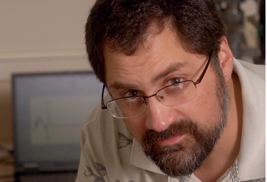Featured Article
Sociology Professor Recognized for Reaching Students Through Pop Culture
The first time Kristen Marcussen stepped into a classroom to teach, visions of passing out ran through her mind. Now, 11 years later, the sociology professor is one of three recipients of the 2010 Distinguished Teaching Award.
read moreGeology Professor and Colleagues Provide Better Understanding of Long-Term Climate Change
Posted Dec. 6, 2010For more than a decade, Dr. Joseph Ortiz, associate professor of geology at Kent State and part of an international team of National Science Foundation (NSF)-funded researchers, has been studying long-term climate variability associated with El Nino. The researchers' goal is to help climatologists better understand this global climate phenomenon that happens every two to eight years, impacting much of the world.

Joe Ortiz
El Nino is the periodic warming of central and eastern tropical Pacific waters. The last El Nino occurred in 2009, Ortiz says, and its impact was felt in the United States with flooding in the south and wildfires in California. The research team looked at El Nino-Southern Oscillation (which is often just called El Nino), reconstructing sea surface temperature of the equatorial Pacific over the past 14,000 years.
"If we understand how El Nino changes over thousands of years, we can better predict climate changes on societal time-scales of years to decades," Ortiz explains. "El Nino variations lead to drought, famine, landslides, fires and other natural disasters, depending on where in the world you happen to be. Our findings can help lead to better ways to predict El Nino-Southern Oscillations, mitigating the natural disasters associated with it."
In addition to Ortiz, the research team includes the lead author on the paper, Thomas Marchitto (University of Colorado); Raimund Muscheler (Lund University in Sweden); Jose Carriquiry (Universidad Autonoma de Baja California, Ensenada in Mexico); and Alexander van Geen (Lamont-Doherty Earth Observatory of Columbia University). Their findings appeared in the Dec. 3 issue of Science, the prestigious journal published by AAAS, the world's largest science society. Their paper, "Dynamical Response of the Tropical Pacific Ocean to Solar Forcing During the Early Holocene," helps to establish the linkage between changes in solar intensity and the strength of El Nino on millennial time scales. Their work was funded by the Marine Geology Subdivision of the National Science Foundation's Ocean Sciences Division.
"The climate system is very sensitive to subtle external forcing," Ortiz says. "We determined that the sun has an impact but is not the sole factor driving changes on these millennial time scales. Other studies have tried to show a solar linkage to El Nino-related climate variability, but our study indicates a convincing linkage due to the continuity of our record. This paper confirms the 'ocean dynamical thermostat' theory, showing that solar-forced changes in ocean circulation have on impact on El Nino.
Ortiz began working with the international team of scientists when he was a post-doctoral scientist at Lamont-Doherty Earth Observatory, a research branch of Columbia University. Over the last 11 years, his contributions to the team include assisting with measurements and in the statistical analysis of the data sets. As a researcher in the Kent State Department of Geology, Ortiz has involved Kent State graduates and undergraduates in his NSF-funded research, providing his students with real-world experience on an international level. His students have participated in research projects as close to home as here in Ohio, and as far away as the South Pacific, North Atlantic, Arctic, Pacific Northwest and off Baja California.
"With my involvement in this project, Kent State geology students have studied core samples collected off Baja California," Ortiz says. "The students can take what they learn in the classroom out into the field and back to the lab. I feel very fortunate to be able to provide our students with this type of experience and bring international-level research to Kent State."
For more information about Kent State's Department of Geology, visit www.kent.edu/geology.
By Emily Vincent